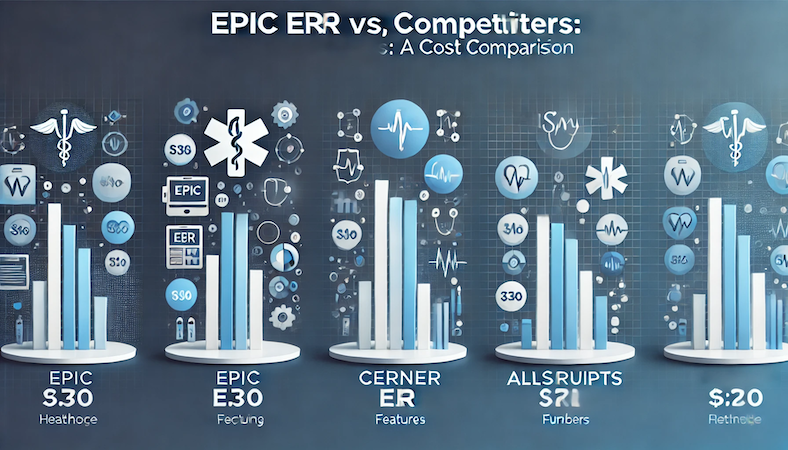If Epic were a luxury car, it’d undoubtedly be a Lamborghini: sleek, powerful, and outrageously expensive. And just like when considering that exotic car, healthcare executives often find themselves asking: “How much does Epic cost?”
It’s not just curiosity—it’s a survival instinct. In 2025, with razor-thin margins, mounting regulatory pressures, and increasingly demanding patients expecting seamless experiences, guessing is no longer an option. You need exact numbers, clear insights, and actionable strategies to leverage Epic without breaking the bank. Consider this guide your financial GPS—no fluff, no jargon, just the precise, actionable insights you need to steer confidently through the maze of Epic pricing and implementation.
Additionally, whether you’re gearing up for regulatory attestation or carefully budgeting for a clinic deployment, knowing the granular details upfront helps ensure you get maximum value without unwelcome financial surprises down the road.
Key Takeaways:
- Epic pricing scales significantly with organization complexity—smaller clinics may face prohibitively high per-user costs, making detailed pre-implementation analysis crucial.
- Understanding and proactively managing hidden implementation expenses—training, maintenance, upgrades—can dramatically lower the total cost of Epic, protecting your ROI from unexpected financial strain.
- Leveraging AI-driven optimizations within Epic early can directly cut operational overhead and improve clinical productivity, significantly offsetting the initial high cost of Epic EHR.
Table of Contents:
- Understanding Epic EHR Pricing in 2025
- Epic EHR Implementation Expenses: The True Cost of Getting Epic Up and Running
- Key Factors Influencing Epic EHR Pricing: Navigating Your Investment Wisely
- Epic EHR vs. Competitors: A Cost Comparison
- Maximizing ROI with Epic EHR in 2025: Turning Costs into Strategic Advantages
- How Topflight Keeps Epic Projects on Budget
- Is Epic EHR Worth the Investment in 2025?
Understanding Epic EHR Pricing in 2025
Let’s cut straight to the chase: implementing Epic isn’t cheap, and healthcare leaders already know that. The real question is, exactly how much will it cost in 2025, and is it still worth the investment?

Epic remains the Cadillac of electronic health records (EHR), but with premium capabilities comes significant cost. To help you strategize effectively, here’s a concise breakdown of Epic EHR pricing tailored specifically to your organization’s size and scope.
Epic EHR Cost Breakdown
To accurately assess Epic EHR cost, healthcare decision-makers should first understand Epic’s main pricing structures and their implications:
Per User Pricing: Decoding the Epic EHR Fee Structure
When examining Epic’s per user pricing model, it’s clear costs can escalate rapidly depending on the scale of your practice:
- Physician licenses: Epic typically charges $5,000–$7,000 per user.
- Other clinical staff: Licenses average around $3,000–$5,000 per user.
- Read-only access: Even minimal access levels cost approximately $500–$1,000 per user.
This Epic EMR pricing model can easily balloon expenses in larger facilities, underscoring the importance of a careful user-needs assessment upfront.
Subscription vs. Licensing Fees: Navigating Epic Pricing Models
Healthcare organizations often face a crucial decision between Epic’s subscription model or traditional licensing fees. Understanding the differences in Epic pricing helps clarify the most cost-effective path forward:
Licensing fees (self-hosted):
- Typically involve a substantial initial investment (often six figures or more).
- Annual fees for ongoing maintenance usually run around 20% of the initial license cost—significantly affecting total ownership cost (Epic software cost).
Subscription fees (hosted/cloud solutions):
- Basic configurations for small clinics can start around $200 per user per month.
- Larger deployments might see subscription fees skyrocketing up to $35,000 or more monthly.
While subscription models lower upfront barriers, monthly expenses over time might exceed self-hosted Epic pricing, especially for larger organizations.
Epic EHR Costs for Hospitals: What’s the Real Damage?
Evaluating Epic EMR costs for a hospital is complex, but here’s a realistic estimate.
Hospitals typically incur initial licensing charges of about $500–$1,000 per bed, meaning a 300-bed medical facility could easily spend mid-six figures on licensing alone.
Adding implementation, training, infrastructure, and support can push these average costs much higher, resulting in millions upfront and substantial monthly expenses—often tens or hundreds of thousands of dollars per month.
Administrators must recognize that these aren’t simply upfront costs; they’re ongoing financial commitments critical to maintaining an enterprise-grade Epic implementation.
Epic EHR Costs for Clinics and Private Practices: Can You Really Afford It?
Determining how much Epic EHR costs for smaller-scale operations like private practices or smaller clinics involves navigating a much different landscape:
- A solo private practice can face upfront costs upwards of $150,000 per location purely for basic implementation—before considering monthly or annual fees.
- Per doctor costs for a small practice frequently run prohibitively high when compared against lighter EHR competitors.
- Even minimal configurations for a small clinic typically exceed budgets that smaller practices anticipate, prompting many to explore Epic alternatives.
Before committing, smaller practices should closely examine Epic’s detailed price list, understanding precisely what the fees cover. For some clinics, choosing Epic might result in eventual system replacement due to financial strain, especially when more affordable alternatives exist that better match their operational scale.
Epic EHR Implementation Expenses: The True Cost of Getting Epic Up and Running
Implementing Epic is more than just software installation; it’s a strategic transformation that carries significant financial implications. Decision-makers must thoroughly understand the EHR implementation cost to ensure realistic budgeting and avoid painful surprises later on. Let’s unpack these critical costs.
Upfront Costs: Software, Hardware, and Infrastructure
The cost of Epic upfront isn’t just about purchasing software—it’s about preparing your entire infrastructure. Here’s an overview of what goes into these substantial startup expenses:
- Software installation: Initial licensing can easily range from $2 million to over $10 million for large-scale hospital projects, making it one of the heaviest line items in your electronic health records implementation budget.
- Hardware & infrastructure: Epic’s demands on medical software systems are substantial, often requiring extensive server and network upgrades. Budget an additional $2–10 million for infrastructure investments if opting for an on-premise deployment.
- Data migration: Transferring existing medical data into Epic isn’t trivial. Allocate between $1–5 million depending on legacy system complexity and the volume of records migrated.
Practical tip: Cloud-based Epic deployments can mitigate some hardware investments, shifting upfront costs into manageable monthly fees.
Hidden Costs: Training, Maintenance, and Upgrades
Don’t let hidden costs derail your Epic implementation. Decision-makers often underestimate these essential yet overlooked components:
- Training: Effective staff training isn’t optional—it’s critical. Expect $2–10 million in initial training expenses for larger health systems. Ongoing refreshers and onboarding new staff add continuous operating costs.
- Maintenance fees & upgrades: These typically represent about 20% annual fees on initial licenses. Regular software updates and system EHR system upgrades are essential for compliance, security, and functionality, often costing large hospitals up to $2 million annually.
- Support staffing: A dedicated internal IT team to manage and maintain your Epic system can cost between $150,000–$500,000 annually, depending on team size and scope of responsibilities .
Challenge: Many organizations initially overlook training and support expenses, creating financial strain post-implementation.
Opportunity: Early planning, clear budgeting, and dedicated resources for training and support significantly improve system adoption rates and reduce downtime, maximizing ROI.
Cloud-Based vs. On-Premise Deployment: Weighing Your Options
Choosing between cloud-based solutions and on-premise technology deployments has major implications for the overall Epic EHR price:
- Cloud-based: Lower upfront costs but higher long-term subscription expenses. Suitable for smaller practices or organizations without extensive IT infrastructure. Ongoing fees are predictable and scalable.
- On-premise: Significant upfront costs, but potentially lower ongoing cost of Epic EHR in the long run—especially advantageous for large healthcare systems with existing robust IT resources.
Recommendation: Conduct a thorough cost-benefit analysis factoring in total cost of ownership over five to ten years. For many mid-size to large organizations, on-premise solutions still offer superior long-term value, provided they have robust internal IT capacity.
Key Factors Influencing Epic EHR Pricing: Navigating Your Investment Wisely
If you’ve gotten this far, you’re already aware that Epic isn’t just software—it’s a strategic business decision. But beyond the obvious line items, multiple nuanced factors significantly affect Epic EHR pricing. Let’s dive into these factors so you understand precisely how they’ll shape your bottom line and practical outcomes.

Organization Size and Complexity: Scaling Costs Intelligently
Epic’s pricing structure isn’t standardized—organizations of different sizes and complexities see dramatically varied Epic medical records cost. Key influencers to keep in mind include:
- Scale & Complexity:
Larger organizations require deeper integration efforts and more extensive modules, amplifying overall costs. Decision-makers, especially chief medical officers, must consider not just upfront fees but also ongoing management overhead when implementing Epic.
- Multi-site Management:
Multi-location systems or networks face increased infrastructure and migration complexity, pushing up total project expenses significantly compared to single-location setups.
- KPI Alert:
Average implementation costs for a 500-provider health network can hit upwards of $80 million, primarily driven by integration and customization.
Customization and Integration Needs: Flexibility at a Price
Your costs will scale sharply if your organization requires substantial workflow customization or system integrations beyond Epic’s native offerings:
- Health App Integration:
Costs rise quickly when attempting to integrate a health app with Epic or even to integrate Allscripts EHR or other legacy systems. Custom interfaces frequently cost around $1,000–$5,000 per interface, and significant integration projects involving multiple systems can rapidly climb into six figures.
- Migration & Workflow Customization:
Data migration and workflow integrations represent significant investments, particularly when integrating specialized tools like remote monitoring, analytics, or telehealth solutions. Employing specialized EHR integration services to smoothly integrate these complex workflows is crucial—budget wisely here, because skimping on integration can cause workflow disruptions and hidden costs downstream.
Opportunity: Strategically evaluate integrations that streamline workflows, rather than merely replicating existing processes, to truly capture Epic’s potential efficiencies.
AI-Driven Cost Optimization Strategies: Maximizing Value for Money
The good news? AI can directly reduce your Epic EMR cost in measurable ways:
Reducing Medical Errors & Optimizing Billing
Adopting AI-driven analytics within Epic can significantly avoid medical errors, improve diagnostic accuracy, and optimize billing processes, directly enhancing ROI and delivering superior value for money.
Automated Documentation & Workflow Management
AI-enhanced documentation, voice recognition, and automated clinical summaries can reduce administrative overhead, freeing clinical staff and directly lowering operational costs, potentially offsetting some Epic implementation expenses.
Actionable Insight: Adopting targeted AI modules in the early stages of implementation significantly mitigates long-term operational costs, boosting productivity and overall financial outcomes.
Challenge: Without proactive planning, integrating advanced AI features can escalate implementation complexity and costs.
Practical Recommendation: Prioritize AI features that directly impact clinical accuracy, billing, and patient engagement—these deliver immediate, tangible returns that justify their investment.
Epic EHR vs. Competitors: A Cost Comparison
Let’s get real—choosing an EHR system isn’t just about ticking regulatory boxes; it’s about picking the solution that delivers the best blend of capability, scalability, and financial sense for your healthcare organization.

While Epic EHR is undoubtedly powerful, its significant Epic EMR price warrants a clear-eyed ehr/emr systems comparison. Here’s a concise yet comprehensive look at how Epic stacks up against its primary competitors in terms of pricing, ROI, and long-term strategic fit.
Epic vs. Cerner: Pricing and Value in 2025
In the heavyweight arena of hospital EHR solutions, Epic and Cerner (Oracle Health) continue their dominance—but their pricing and strategic value propositions differ significantly:
Licensing & Subscription Costs
Epic: Customized upfront contracts or subscription pricing typically starts at about $1,200 per user or a minimum of around $500,000 for substantial deployments.
Cerner: More predictable, cloud-based pricing models, beginning around $25 per user monthly, making Cerner substantially more approachable for mid-sized or community-focused health systems.
Implementation Expenses
Epic: Implementation projects often exceed $500K even for mid-sized organizations, reaching into tens of millions for larger institutions (for context, Northwell Health’s recent Epic rollout exceeded $1 billion).
Cerner: Implementation typically ranges from $150,000–$300,000 for mid-sized hospitals—noticeably less than Epic.
Maintenance and Support
Epic: Annual support generally equals about 15-20% of licensing fees (hundreds of thousands annually for large hospitals).
Cerner: Lower annual maintenance costs, often around $100,000 annually for average-sized hospitals.
Practical Insight
Epic offers superior enterprise capabilities and scalability, but Cerner often provides quicker ROI due to lower upfront and ongoing costs. Organizations must evaluate their actual need for Epic’s broader functionality before committing.
Epic vs. Allscripts: Which Offers Better ROI?
If your organization’s priorities lean more towards cost sensitivity and ease of adoption, Allscripts (Veradigm) might be a smarter choice. Here’s why:
Pricing Structure & Service Charges
Allscripts: Subscription plans often start around $500–$1,500 per provider per month, ideal for smaller practices aiming to avoid Epic’s significant upfront cost and service charges.
Epic: Generally, custom-quoted pricing scales significantly higher, particularly for larger implementations, making it less practical for tight-budget clinics.
Implementation & Scalability
Allscripts: Small practices report implementation costs around $75,000, significantly lower than Epic’s six-figure minimums. Even a 300-bed hospital spent approximately $2 million on Allscripts compared to tens of millions for an equivalent Epic rollout.
Epic: Scalable upwards and well-suited for large integrated networks, but often prohibitive for smaller organizations.
User Experience & Efficiency Gains
Allscripts: Known for a simpler interface with quicker onboarding, meaning reduced training overhead and less operational disruption.
Epic: Offers deeper integration and advanced analytics but demands significant training resources and higher initial complexity.
Practical Takeaway
Allscripts provides rapid implementation, lower service charges, and quick adoption—perfect for smaller to mid-sized groups prioritizing quick wins and straightforward usability. However, for comprehensive, integrated medical history tracking and deep interoperability, Epic is unmatched in the long run.
Deciding Between Epic, Cerner, and Allscripts
When evaluating which vendor fits your organization’s strategic objectives, consider these critical dimensions:
| Factor | Epic | Cerner | Allscripts |
| Initial Investment | High ($500K – millions) | Moderate ($150K – $300K) | Lower ($75K – $2M) |
| Annual Support Costs | High (15-20% licensing) | Moderate (~$100K annually) | Moderate (varies widely) |
| Scalability | Best for large hospitals | Scalable (mid-large) | Ideal for small practices |
| Ease of Adoption | Complex, extensive setup | Moderate complexity | Easier, faster adoption |
| ROI Horizon | Long-term, strategic | Mid-term, balanced | Short-term, immediate gains |
Ultimately, while Epic might lead in capability and enterprise-scale solutions, decision-makers must evaluate carefully whether the premium is justified for their specific scenario, or if Cerner or Allscripts present stronger financial logic, especially in smaller or medium-sized environments.

Maximizing ROI with Epic EHR in 2025: Turning Costs into Strategic Advantages
In healthcare, ROI isn’t just about financial returns—it’s about enhancing patient outcomes, boosting efficiency, and yes, making your CFO smile at quarterly reports. One of the most common questions we hear from healthcare decision-makers is: “How much does Epic EHR cost?”
The truth is, Epic isn’t cheap, and achieving strong ROI demands strategic thinking and proactive planning. Let’s unpack exactly how to make every dollar spent on Epic count, leveraging practical solutions and emerging technologies.
Additionally, whether you’re preparing for regulatory attestation or simply budgeting for a clinic, it’s essential to dive into the granular details of Epic’s cost structure to avoid surprises and maximize the value you derive from this robust platform.
AI-Powered Workflow Enhancements: Streamlining for Efficiency
Epic implementations provide a golden opportunity to enhance workflows through integrated AI solutions. By incorporating advanced AI-driven features into your healthcare app development strategy early, you can significantly cut operational overhead, increase clinician productivity, and directly impact patient outcomes.
Key Opportunities:
- Automated Documentation: Voice-driven AI reduces clinician documentation time by up to 45% per year, freeing medical staff for direct patient care.
- Clinical Decision Support: AI-driven predictive analytics embedded in Epic can drastically decrease preventable readmissions, generating substantial savings annually.
Challenges & Limitations:
- High initial investment for AI modules may intimidate smaller clinics or private practices.
- Resistance from clinicians if AI integration is perceived as disruptive.
Practical Advice:
Start small—implement high-impact, low-disruption AI tools first (like speech-to-text) and expand into predictive analytics as user comfort grows.
Reducing Hidden Costs with Smart Implementation: Efficiency at Scale
Hidden expenses—often lurking within training, customization, and system support—can sabotage Epic’s value proposition if not proactively managed. Strategic planning is critical to avoiding these budgetary black holes.
Actionable Strategies from our EHR software development guide:
- Standardize First, Customize Later: Initial standardization of Epic implementation reduces upfront costs significantly. Epic customizations can be added incrementally as workflows stabilize.
- Proactive Training: Establish “super-user” training programs to lower ongoing training expenses, reducing recurring maintenance fees and operational inefficiencies.
- Strategic Partnerships: Collaborate with certified Epic consultants who specialize in efficient deployments—reducing long-term support and upgrade costs.
KPI to Watch:
Organizations using targeted, upfront standardization and training best practices report a 25–30% reduction in hidden costs within the first two years post-deployment.
Long-Term Benefits of Epic EHR for Healthcare: Planning for Sustainable Success
Epic’s initial price tag is daunting, but the Epic electronic health record cost must be evaluated against substantial long-term benefits—far beyond immediate operational efficiencies. Strategically, Epic positions healthcare organizations for sustained competitive advantage.
- Operational Excellence: Epic consistently reduces overall operating costs by integrating financial, clinical, and administrative data into one cohesive platform, reducing redundancies significantly.
- Regular Upgrades & Innovation: Included in your subscription or license fees are ongoing enhancements that improve patient care and maintain compliance with regulatory requirements.
- Patient Engagement & Satisfaction: Epic’s integrated patient portals and communication platforms improve patient satisfaction scores—critical KPIs on consumer-oriented websites like Healthgrades or patient review sites, directly impacting your organization’s market position.
Practical Takeaway:
Plan financially for a 5-10 year horizon, leveraging Epic’s ongoing improvements. Healthcare leaders report seeing tangible operational benefits within the first three years, with deeper ROI realized beyond year five.
How Topflight Keeps Epic Projects on Budget —and on the Marketplace
Epic roll-outs spiral past forecasts when every workflow tweak means bespoke code, a fresh HIPAA review, and another pass through App Orchard gatekeepers. We shortcut the pain: our engineers have already shipped Epic-connected apps that stream wearables (RTHM), drive computer-vision rehab (Allheartz), and sailed through Connection Hub on the first submission. These wins didn’t just save calendar time—they helped clients lock in $188 million+ in follow-on funding, proof that disciplined budgets and investor traction go hand-in-hand.
And we don’t stop at integration. From launch analytics that surface ROI for CFOs to optimization sprints that trim per-patient licensing costs, Topflight turns Epic into a growth lever instead of a cost center.
Why teams pick Topflight for Epic EHR integration
-
App Orchard / Connection Hub muscle – Sandbox setup, OAuth creds, pixel-perfect review: we handle the red tape so your listing goes live minus déjà-vu resubmissions.
-
Cost-controlled sprints – Pre-vetted SMART on FHIR connectors and reusable UI blocks shave weeks off dev time (and six figures off burn).
-
Compliance baked in – HIPAA, SOC-2, and PKCE from sprint one; no last-minute “security tax.”
-
Investor-proven ROI – Apps we’ve built help founders close nine-figure rounds—evidence your board will actually care about.
Ready to make Epic behave like your product—without torching the budget? Let’s talk.
Is Epic EHR Worth the Investment in 2025?
By now, it’s clear: Epic EHR is a significant financial decision that can redefine your healthcare organization’s operational landscape—but only if approached strategically. Its enterprise-grade capabilities, deep integrations, and advanced AI-driven workflows offer exceptional value for money, provided you’re ready for the substantial upfront investment. But let’s revisit the essential question decision-makers often ask: how much does Epic EMR cost in reality?

Given Epic’s sizable financial commitment, it’s critical to develop a clear, detailed plan that aligns closely with your organizational goals, size, and long-term objectives. For many healthcare leaders, the measurable improvements in patient outcomes, clinician productivity, and streamlined workflows justify Epic’s premium pricing—assuming thoughtful deployment, rigorous budgeting, and strategic integration are part of your roadmap.
Bottom line: If your organization’s scale and operational complexity justify Epic’s high costs, and you’re strategic about managing hidden fees, Epic remains a strong contender to drive substantial healthcare improvements and long-term returns.
Frequently Asked Questions
Can smaller clinics realistically afford EPIC EHR?
Standalone small clinics usually struggle with Epic’s high upfront costs. However, joining larger community-hosted Epic systems or consortiums can significantly lower expenses, making Epic more financially viable for smaller providers.
How long does an average EPIC implementation take?
For large hospitals, expect 18-24 months from planning to go-live. Smaller clinics typically see timelines closer to 6-12 months, depending heavily on customization and data migration complexity.
How often does EPIC update its software, and does this incur additional costs?
Epic typically rolls out updates quarterly. While minor updates are covered by annual fees, significant upgrades or custom enhancements can involve additional service charges—so always budget accordingly.
What's the typical timeframe to achieve ROI from EPIC implementation?
Most organizations see initial operational improvements within 1–2 years, but significant ROI typically materializes 3–5 years post-deployment, once adoption stabilizes and workflows become optimized.
Can we migrate data ourselves to reduce EPIC EHR implementation costs?
Self-managed migrations can save money initially but often lead to data errors and workflow disruptions. Professional EHR integration services are recommended to ensure accuracy, compliance, and smooth operations.
Does EPIC support interoperability with other EHR systems like Allscripts or Cerner?
Yes, Epic does offer integration with major EHR vendors, but custom interfaces can become costly. Budget $1,000–$5,000 per interface, and clearly define your interoperability goals to control expenses.